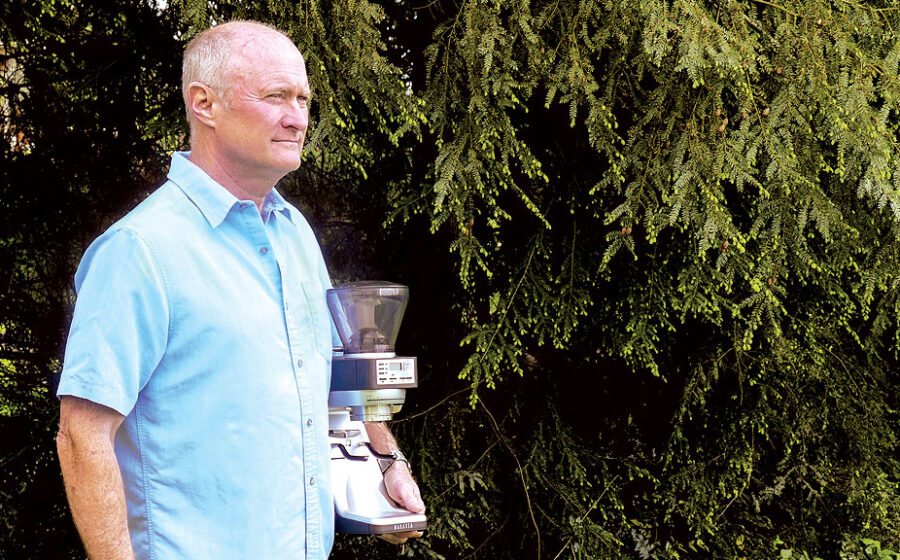[O]ne of the most seemingly out of place machines on the counter of a café is a Baratza grinder. It sits there, a diminutive little guy beside its towering fellow grinders. If the counter is recessed, it might be wholly out of customers’ sight. An airpot of coffee weighs more than it. It’s the coffee equipment equivalent of Muggsy Bogues: small, but it can play with the best. And it does. A lot.
That’s not what Kyle Anderson expected when he started Baratza with Kyra Kennedy. Their plan was to import and sell home espresso machines, but then a grinder they licensed was a big success. It showed them there was a hunger for a better class of home grinder. That led Anderson, an inventor with a pretty major innovation to his credit, to make Baratza’s first grinder. The idea was for it to be a great home grinder. Our industry had other thoughts.
This summer, their newest line of grinders, the Sette, will take posts on café bars. With a conical burr whose outside ring is the one that rotates and a built-in Acaia scale, it’s a show-stopping grinder with a gorgeous design. As cool as it is, I mainly wanted to find out more about the guy who created it.
Right off the bat, I learned that beside the great Kaldi himself, Anderson might have the greatest possible answer to the simplest question in our business.
This interview has been edited for clarity and space.
How did you get started in coffee?
Back in 1989, I invented, with my tennis partner, the world’s first super-automatic espresso latte machine. To say it was disruptive was a bit of an understatement. I started that company in the basement of my house. We grew pretty rapidly and we introduced espresso to 7-Eleven, McDonalds, Washinton State Ferries, corporate cafeterias. The name of the company was Acorto. These were strictly commercial machines: 300 pounds, $17,000 each. It was a big deal. It had built-in refrigeration, two grinders, a huge, Italian brewing mechanism in it. It was a bit of a paradigm shift that you could push a button and make really good espresso or espresso-based drinks. So that’s how I got into coffee, and I was just in the commercial side of things.
You left Acorto, which is now Concordia, in 1999. Why not stay in espresso machines?
Kyra and I started this company with a specific intent (I had a non-compete when I left Acorto) not to compete on the commercial side. Initially we set out to bring in little automatic home espresso machines. What we found, about a year into that business, was that Solis also had a little coffee grinder. We were amazed at how it sold. We decided to create our own grinder, so we created the Maestro in 2001. We did some innovative stuff with the Maestro and it was quite the success. In 2004, we decided to sell the espresso machine side of the business and dedicate ourselves to coffee grinders. That was the year we introduced the Virtuoso, which was our grinder through and through.
The Sette, particularly the one with the Acaia scale, is a culmination of a lot of the innovations you’ve brought to grinders. Where have those ideas come from?
All of our best ideas have come from customers. Weight-based grinding came from Jared Rennie at Noble Coffee down in Oregon. He was using our Virtuoso on their coffee bar. He said, “Have you ever thought about incorporating a scale in your grinder?” And I said, “No!” I got out a napkin, this was at the SCAA show in Anaheim, and I just sketched a quick idea and he said, “Yeah! That would be perfect!”
That’s amazing.
And we did it. That’s where weight-based grinding came from. It really kind of shook the world up.
I find it surprising that a guy who invented the super-automatic is the guy who makes the grinder for pour-overs, the most hands-on way of making coffee.
Yes and no. There’s a common thread here. We took a look at what people were doing at the beginning of this third-wave thing, and looked at all these little tins sitting around being stacked up in the café, with baristas in the morning pulling individual beans out to get as close as they can to a couple tenths of a gram. And we took a look at that, and it just harkened back to my days at Acorto, and I said, “This is stupid.” Talk about wasteful in terms of time. We strive to make our grinders a tool that helps you make better coffee. And a tool makes the work you have to do easier. And though it is part of, you’re right, manual brewing, we’re trying to take dialing in of the right grind and getting the right dose, we’re trying to eliminate those two variables so you can nail it. We’re still using a machine to do what could be done some other way, but to make it really easy. In that way, it’s consistent with where I started.
—Cory Eldridge is Fresh Cup‘s editor.
















